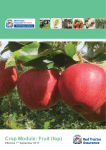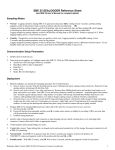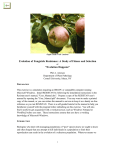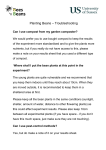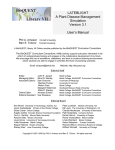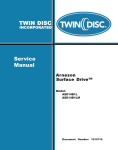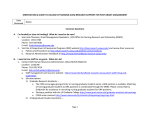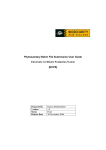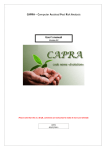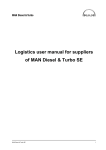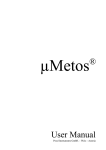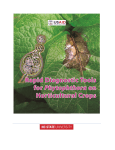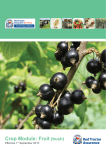Download The Irish Potato Famine Revisited—Again, Again, and Again
Transcript
Simulation of Potato Late Blight Epidemics or "The Irish Potato Famine Revisited—Again, Again, and Again" Phil A. Arneson Department of Plant Pathology Cornell University, Ithaca, NY PREPARATION LATEBLIGHT, a plant disease simulator used in this exercise, requires an IBM-PC or compatible computer running Microsoft Windows. Install LATEBLIGHT by following the installation instructions in the Lateblight user's manual, "User_Manual.doc". Prepare a copy of the LATEBLIGHT user's manual by opening the "User_Manual.pdf" document. You may want to make a printed copy of the manual, or you can reduce the manual to an icon to keep it as a handy on-line reference as you run LATEBLIGHT. There is a self-guided tutorial in the manual to help you familiarize yourself with the program before embarking on this exercise. It would also be useful for you to acquaint yourself with an ASCII text editor, such as Windows Notepad, before attempting the exercise. These instructions assume a working knowledge of Microsoft Windows. INTRODUCTION LATEBLIGHT is a plant disease management game that is based on a computer simulation model of late blight of potato caused by Phytophthora infestans. The model was originally developed by Bruhn and Fry (1981) and was adapted for the Microsoft Windows environment by B. Ticknor and P. Arneson of Cornell University. The LATEBLIGHT simulation model operates on a daily time step and simulates the effects of environment, host, and management activities on the asexual development of P. infestans in association with the potato host. This exercise will allow you to examine the development and control of potato late blight epidemics. You will run a series of simulations and compare results using different starting values or management actions to examine the interactive effects of weather, amount and source of initial inoculum, and the use of protectant fungicide sprays on disease development and on profitability. PROCEDURE General instructions. Start the program by double-clicking on the LATEBLIGHT icon. Before running any simulations, save default values by clicking File, Save as... and type startup.lbt when prompted for the file name. Open this file at the beginning of each simulation to reinitialize the variables to their default values. Other "start-up" files can be created in the same way by setting the variable values and saving the file for later retrieval. After opening the startup.lbt file, default values such as cultivar resistance (from the Potato menu), amount of initial inoculum (from the Inoculum menu), commodity price or fungicide costs (from the Economics menu), may be changed before running the simulation. For the exercises below, assume default values unless the problem specifically requires a change to be made. After starting values are selected, start the simulation by clicking File, Run. When prompted, choose the appropriate weather file from the list by double-clicking on the file name or clicking once on the file name and then on Open. There are several different ways of advancing through time in the simulation using the scroll bar at the bottom of the screen. Clicking on the arrow at the right will advance time one day at a time; clicking on the scroll bar will advance time one week at a time; and dragging the "thumb" The Irish Potato Famine Revisited 2 will allow you to advance to any arbitrary date. Keystrokes can also be used. The <+> key will advance one day at a time, the <Ctrl> <+> combination will advance one week at a time, and <End> will advance directly to the end of the season. Just as in real life, you cannot go back in time, so move forward carefully! On any day during the season, weather reports and forecasts can be accessed through the Environment menu, and fungicides can be applied by selecting from the Management menu. At the end of the season, a summary of your results, including final disease severity, fungicide application costs and net profit or loss, can be viewed by selecting Report from the Economics menu. To keep a record of the various simulations for incorporation into a report, it would be a good idea to create a log file on the disk. This could be done by creating one huge file for all the runs, but some editors (e.g., Windows Notepad) cannot handle such large files. It would facilitate later editing of these files if you made a separate file for each run. To log a single season, at the end of each run click on File, Log to Disk..., give the file an appropriate name, and then click on File, Close Log File. To log several seasons, open the log file at the start, and close it when you have finished. 1. Influence of weather on disease development. Open the default parameter file by clicking File, Open… and double-clicking startup.lbt. Open a log file (to record your results) by clicking File, Log to Disk… and typing the file name WEATHER.TXT in the box. Start the simulation by clicking File, Run. When prompted, choose the weather file hotdry.lwx from the list by double-clicking on the file name or clicking once on the file name and then on Open. Advance the simulation to the end of the season by pressing the <End> key on the keyboard. Note what percent of the foliage was blighted by pointing the cursor and the end of the black line and pressing the left mouse button. Click on View and click on Rainfall to note the rainfall events for the season. Start a new season by clicking File, Open… and double-clicking startup.lbt again. (Note: click "yes" to "Save current season?" only if you wish to view the graph again.) Click File, Run and this time choose the weather file moddry.lwx proceeding as before. Repeat these steps using the modmod.lwx, modwet.lwx, and coolwet.lwx weather data sets. At the end of this set of simulations, close the log file by clicking File, Close Log File. Open the log file in a text editor and review the data. Question 1: (a) What environmental conditions are most favorable for the development of late blight? (b) Where in the world would you expect late blight to be the most serious disease problem on potatoes? (c) What are the implications for year-to-year variability in late blight severity in a given location? 2. The impact of sanitation on disease development. In the management of late blight, we have to be concerned about the source of inoculum (the spores or initial lesions that start the epidemic). The initial inoculum can come from outside our potato field and arrive as windblown sporangia (a type of spore). The most common sources are neighboring infected fields and nearby cull piles (potatoes discarded from the packinghouse). The initial inoculum can also come from within our field, on lesions on sprouting volunteer potatoes (germinating The Irish Potato Famine Revisited 3 tubers left in the field from the previous crop) or on infected seed tubers that were planted this season. To examine the impact of initial inoculum, let's make the cull pile the only source of inoculum and try moving it different distances from our field. Reset the parameters to the default values with File, Open… startup.lbt. Start another log file with File, Log to Disk… and call it CULLPILE.TXT Next click on Inoculum, Infections, Number to be sure that the inoculum from sources within the field is set to zero. Then click on Inoculum, Sporangia, Sources and set the inoculum coming from an unsprayed, neighboring field to zero and the inoculum coming from a cull pile 10 meters away to 1000 sporangia per day. Run the simulation as before, using the coolwet.lwx weather dataset. Repeat the simulations, setting the cull pile at 50, 100, and 200 meters from the field. Don't forget to close the log file at the end! Question 2: What should be the minimum distance of a potato cull pile from a potato field? 3. Certified seed. The late blight fungus can survive from one season to the next by infecting the potato tubers. When the tubers or tuber pieces are planted as seed the following season, the fungus can begin growing with the sprouting tubers, and the resulting lesions produce sporangia that can be dispersed by the wind to healthy potato plants. If a potato grower is reasonably certain that his tubers are clean, he might risk saving some of them for seed. On the other hand, he can reduce his risk by buying "certified seed", grown by certified seed producers under rigidly controlled phytosanitary conditions. Suppose that by using non-certified seed you would get 100 infections per hectare at emergence. Further suppose that by buying certified seed you are able to reduce the number of infections to 1 per hectare. After opening the startup.lbt file and starting as new log file, click on Inoculum, Sporangia, Number... to set the inoculum coming from outside the field to zero, and then click on Inoculum, Infections, Source... to the number of infected seed per hectare at emergence to 100. Use the cool, wet weather data set (coolwet.lwx). Repeat the simulation using 1 infected seed per hectare. Question 3: Can you think of any circumstances under which you might decide to plant your own seed tubers rather than buy certified seed? 4. Protectant fungicide applications. Another management option that a potato grower has available is to apply a fungicide at regular intervals (usually roughly weekly) to protect the foliage from infection. Of course, there are costs associated with this approach, both monetary costs to the grower and environmental costs (which are difficult to evaluate). Initialize the simulation with the same parameters as in #3, above, using the initial level of infection equivalent to certified seed. (Open startup.lbt, set the Inoculum to zero sporangia and 1 infected seed tubers per hectare, and select the coolwet.lwx weather file.) Open a new log file to record the results. The Irish Potato Famine Revisited 4 Advance the season to July 20 by dragging the "thumb" on the scrollbar to the right until the date indicator reads July 20. (Note: If you cannot see the date indicator, enlarge the window by pulling the lower, right corner downward and to the right.) Click on Management, Spray Protectant… to apply the fungicide spray. (Accept the recommended dose by clicking OK.) Advance time by one week by pressing <Ctrl><+>, and apply another spray. Press <End> to advance time to the end of the season, and examine the results in the Economics, Show Report window. Repeat the simulation for 4, 6, and 8 fungicide sprays. Question 4. If your objective were to maximize profits, how many applications of the fungicide wold you make? Would your decision be different if did not use certified seed? FURTHER READING Bruhn, J.A. and Fry, W.E. 1981. Analysis of potato late blight epidemiology by simulation modeling. Phytopathology 71:612-616. The Irish Potato Famine Revisited 5





